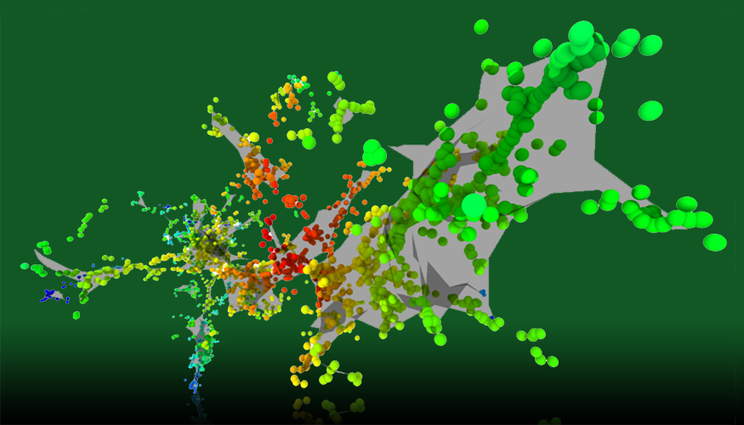Pulsed ion beams reveal nonlinearity of radiation defect dynamics in silicon carbide
 (Download Image)
Snapshot of simulated 500 keV Xe as it cascades into silicon carbide.
(Download Image)
Snapshot of simulated 500 keV Xe as it cascades into silicon carbide.
Materials scientists at Lawrence Livermore National Laboratory (LLNL) got a step closer to understanding defect interaction dynamics in silicon carbide.
When an energetic particle, such as a neutron or an ion, impinges onto a material, the particle penetrates and creates displacements by ballistic processes of knocking off lattice atoms from their equilibrium positions. These knocked-off atoms often have kinetic energy high enough to displace other nearby atoms. As a result, a cascade of atomic displacements is created along the ion trajectory.
Energetic ions with different masses create collision cascades with different displacement densities. Heavy ions create dense collision cascades, while cascades produced by light ions and neutrons are diluted with much larger average distances between displacements within each cascade.
Such cascade densities are not just an intellectual curiosity. For many non-metallic materials, the density of collision cascades determines how easily the material gets damaged under irradiation. However, the effects of collision cascade densities on radiation defect dynamics remained essentially unexplored. Radiation defect dynamics generally remains one of the most complex, poorly understood and heavily debated topics in the radiation damage community.
Silicon carbide is used to power electronic devices, such as a transistor, that operate at high-temperature and high-voltage. Furthermore, silicon carbide has been investigated for its feasibility as nuclear fuel cladding.
In a study published in the March 17 edition of Scientific Reports, a team from LLNL and Texas A&M University used a recently developed pulsed ion beam method to investigate how radiation damage in silicon carbide is influenced by the density of collision cascades. Silicon carbide is a nuclear ceramic and wide-band-gap semiconductor material. The team systematically studied radiation defect dynamics in silicon carbide bombarded with different ions that create collision cascades with densities in a wide range. The researchers used pulsed ion beams to measure lifetimes of mobile defects and developed a new method to calculate cascade densities.
The team found that denser collision cascades not only create more damage but also evolve much slower than diluted cascades. Their work is the first demonstration that, in addition to the dose rate, defect interaction dynamics in silicon carbide strongly depends on the cascade density.
"This study is another example of how the development of novel experimental methods can help us better understand the basic radiation damage processes," said LLNL scientist L. Bimo Bayu Aji, the lead author of the paper.
"This work shows that silicon carbide is expected to damage differently in radiation environments characterized by different neutron fluxes and energies, and that any truly predictive modeling of radiation damage needs to include defect interaction dynamics," said Sergei Kucheyev, the LLNL project lead.
This research was funded by the Nuclear Energy Enabling Technologies (NEET) Program of the Department of Energy, Office of Nuclear Energy. LLNL researcher Joseph Wallace also contributed to this project.
Contact
 Anne M. Stark
Anne M. Stark
[email protected]
(925) 422-9799
Related Links
Scientific ReportsNuclear Energy Enabling Technologies
Tags
Physical and Life SciencesFeatured Articles







